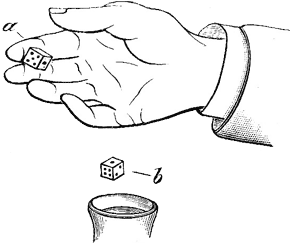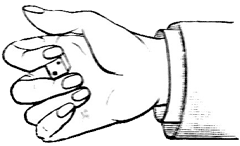
|
foreword to the online edition I. introductory II. common sharpers and their tricks III. marked cards and the manner of their employment IV. reflectors V. holdouts VI. manipulation VIII. the game of faro IX. prepared cards X. dice XI. high ball poker XII. roulette and allied games XIII. sporting houses XIV. sharps and flats
|
SHARPS AND FLATS
CHAPTER X DICE
Dice SwitchesUnfair dice are seldom submitted for inspection, as may well be imagined, particularly those of the dispatcher kind. The greatest donkey in existence would at once find that the number of pips upon the faces of these latter was incorrect. Therefore they are always introduced into the game whilst the play is occupying the dupe's undivided attention, and the manner of their introduction is that embodied in the process known as 'ringing-in.' This is done at the moment when the dice are taken up in order to throw them into the box. It is only possible to change one die, the others are allowed to fall into the box in the usual way. Supposing that two dice are being used, two fair ones will be employed, and with these the dupe will throw. The sharp, however, has a false die concealed in his right hand, and held in the thumb joint. He picks up the two fair dice from the table, in the manner described in 'securing,' and allows one of them to fall into the box. FIG. 55 Then, of course, he has still two dice in his hand, one genuine one between his fingers, and one false one held by his thumb. In figs. 55 and 56, a is the genuine. die and b is the false one. FIG. 56 At the same instant that the first die is allowed to fall, the false die b is dropped into the box also (fig. 56). Immediately the false die is released the two fingers holding the second genuine one are turned inwards (fig. 57) an d the die is taken into the thumb-joint, in the position formerly occupied by the false one. The whole of this manipulation is performed in the act of throwing the dice into the box. The false die is dropped into the box, and the genuine one put into its place at the root of the thumb in one movement only, and the exchange is instantaneous. The fingers are well bent before any of the dice are dropped, so that the second genuine die has the least possible distance to travel in its movement towards the thumb-joint.
FIG. 57 From the manipulations outlined above, the reader will observe that the skill required is less in the case of dice than in that of cards; but he must not run away with the idea that, because the methods of swindling with dice are comparatively simple, the dice-sharp requires but little practice to enable him to carry out his operations successfully. That is by no means the case. It is frequently the amateur's lot to find that those things which appear simplest in theory are the most difficult in practice. The sharp who seeks his fortune by manipulation of the 'ivories' has to devote many weary hours to the acquisition of deftness in the manúuvres which he intends to employ.
We may now proceed to consider the application of the foregoing principles to the purposes of cheating, and see how they are employed in actual practice. In this we cannot do better than follow the sharp's operations in connection with one or two games which are commonly played. This will serve to give the reader a more adequate conception of the manner in which this style of cheating is conducted. The games selected for this purpose, then, are: 'Over and under seven,' 'Yankeegrab' or 'Newmarket,' 'Sweat,' and 'Hazard.'
|
| « dice (cheating with crooked dice) | dice (over and under seven) » |
home | introduction | book content | links | advertising | contact


